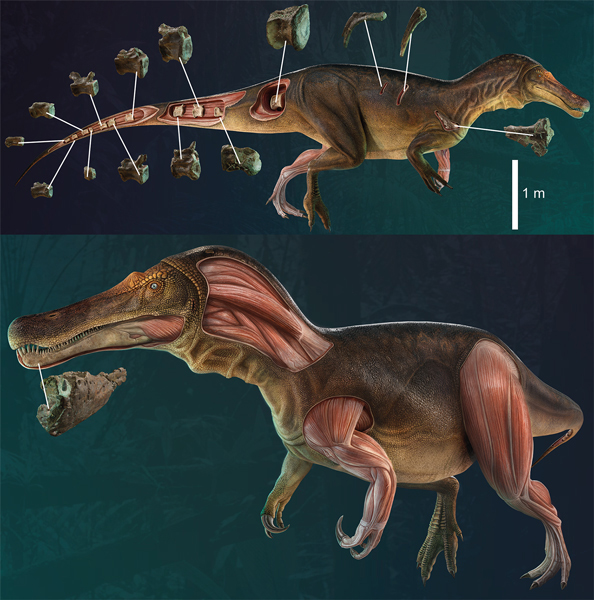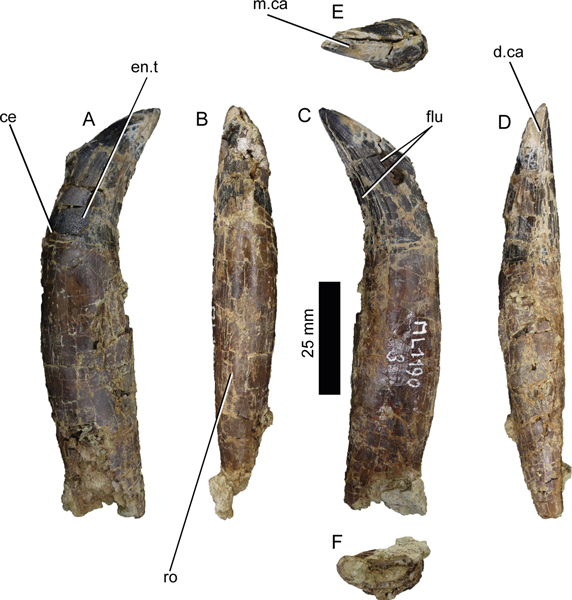Scientists have announced the discovery of a new spinosaur species from Portugal. Iberospinus (I. natarioi), from Lower Cretaceous deposits associated with the Papo Seco Formation. Its discovery further supports the theory that these enigmatic theropods originated in western Europe.
Estimated to have been around eight metres in length, Iberospinus is the third spinosaur* to have been described based on fossil material found on the Iberian Peninsula. The scientific description of this taxon reinforces the idea that Iberia was a hotspot for spinosaur biodiversity, with several endemic genera having been identified from fossils found in this region.

Iberospinus natarioi “Natário’s Iberian Spine”
Researchers Octávio Mateus and Darío Estraviz-López (NOVA School of Science and Technology, Caparica, Portugal), writing in the open-access journal PLOS One reassessed fossil material, originally found in 1999 and attributed to Baryonyx, combining this new study with an analysis of further fossil material recovered from the excavation site in the summer of 2020.
The scientists, both of whom work at the famous Museu da Lourinhã, Lourinhã (Portugal), identified a number of unique characteristics in the fragmentary fossils that permitted them to propose a new taxon. For example, CT scans revealed Iberospinus has a unique neurovascular system associated with the Meckelian groove in the lower jaw. The anterior portion of the lower jaw has a straight-profile and does not point upwards, an anatomical trait seen in other spinosaurs. The partial pubis is thickened towards its distal end and these autapomorphies permitted the erection of a new taxon
A New Spinosaur from Portugal
Iberospinus has been classified as a basal member of the Spinosauridae as its skeleton shows an intermediate condition between early tetanuran theropods and spinosaurids.
The dinosaur’s genus was inspired by the Roman name for the Iberian Peninsula and “spinus” from the Latin for spine in recognition of the long neural spines associated with spinosaurids. The species name honours amateur fossil collector Carlos Natário, who discovered the holotype fossil (specimen number ML1190) in 1999 and helped to ensure that it was placed within the vertebrate fossil collection of the Museu da Lourinhã.

Different Spinosaurs Co-existing in the Same Environment.
The large tooth complete with root was also described in the scientific paper. It possesses characters associated with the Baryonychinae subfamily of spinosaurs. The tooth crown is strongly recurved whilst more advanced and geologically younger members of the Spinosauridae such as Spinosaurus aegyptiacus tend to have straighter, conical teeth.
This reassessment of Iberian theropod fossil material demonstrates that different spinosaurid taxa co-existed within the same environment. The occurrence of more than one spinosaurid genus in a relatively restricted geographical area has been reported before, most recently with the naming of two new genera of spinosaurs (Riparovenator milnerae and Ceratosuchops inferodios) that co-existed in the Lower Cretaceous of southern England with Baryonyx (B. walkeri).
To read Everything Dinosaur’s earlier article about the recently described Isle of Wight spinosaurs: Two New Spinosaurids Described from the Isle of Wight.

Iberian Spinosaurs*
Despite the lack of relatively complete fossil material, specimens collected from the Iberian Peninsula represent one of the best accumulations of spinosaurid fossils found to date. After Baryonyx (B. walkeri) was formally named and described in 1987, several fossils from this region were ascribed to this taxon. However, more recent analysis and further fossil discoveries has led to a revision and at present three contemporaneous spinosaur taxa have been attributed to this region.
- Camarillasaurus cirugedae – from Teruel Province (north-eastern Spain). Formally named and described in 2014. Previously thought to represent a ceratosaur, now regarded as a member of the Spinosauridae.
- Vallibonaventrix cani – from the Castellón Province (north-eastern Spain). Named and described in 2019, the taxonomic position of this genus remains uncertain although the current consensus is that the fossils do represent a member of the Spinosauridae family, but there is an on-going debate as to whether Vallibonaventrix is a member of the Baryonychinae or whether it is more closely related to Spinosaurus aegyptiacus.
- Iberospinus natarioi – newly described (2022, Mateus and Estraviz-López) from the Papo Seco Formation of Cabo Espichel, Sesimbra, Portugal.
The scientific paper: “A new theropod dinosaur from the early cretaceous (Barremian) of Cabo Espichel, Portugal: Implications for spinosaurid evolution” by Octávio Mateus and Darío Estraviz-López published in PLOS One.
Visit the Everything Dinosaur website: Everything Dinosaur.






Leave A Comment